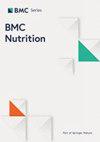Development and validation of food frequency questionnaire screener software for sodium intake among palestinian population
IF 1.9
Q3 NUTRITION & DIETETICS
引用次数: 0
Abstract
High sodium intake has been linked to negative health effects, including cardiovascular and renal diseases. Traditional dietary sodium assessment methods are time-consuming and subjected to errors. Using technology may increase the efficiency and accuracy of dietary assessment. The objective of this study is to develop and validate a food frequency questionnaire (FFQ) screener using software to assess sodium intake among the Palestinian population. Methodology: The study was conducted in four phases. In Phase 1, Palestinian foods were categorized and subcategorized according to their mode of consumption, sodium content, and food groups. The sodium content values were calculated from Palestinian food composition database. Content validity was done in Phase 2, while in Phase 3, a pilot study was conducted to determine test-retest reliability. In Phase 4, the criterion validity of the screener was assessed by comparing the results of sodium intake from the FFQ screener with the results from a 24-hour urinary sodium test and a 3-day diet recall. Correlations between the sodium intake values from the three methods were analyzed using Pearson correlation tests, and the difference was assessed using the Bland-Altman test. The developed FFQ screener sodium screener included 41 food items categorized into nine groups, with photo-based portion size estimation and frequency of consumption. The reliability test showed a Pearson correlation coefficient of 0.7, p < 0.01 using test and retest. For criterion validity, the correlation coefficient between dietary sodium intake using the FFQ screener software and the 24-hour urine sodium test was (0.6, p < 0.000). The correlation coefficient between dietary sodium intake using the FFQ screener software and dietary sodium intake using a 3-day recall was (0.3, p < 0.000). Sodium intake was significantly correlated with preferences for low-sodium food and previous salt reduction, p < 0.05. Using the FFQ screener software was a valid and reliable method for assessing dietary sodium intake. Using the photo-based method to estimate portion size improved precision and accuracy in diet assessment.针对巴勒斯坦人口钠摄入量的食物频率问卷筛选软件的开发与验证
高钠摄入与心血管和肾脏疾病等负面健康影响有关。传统的膳食钠评估方法耗时且容易出错。使用技术可提高膳食评估的效率和准确性。本研究的目的是利用软件开发和验证食物频率问卷 (FFQ) 筛选器,以评估巴勒斯坦人口的钠摄入量。研究方法:研究分四个阶段进行。在第一阶段,根据食用方式、钠含量和食物类别对巴勒斯坦食物进行分类和细分。钠含量值由巴勒斯坦食品成分数据库计算得出。第 2 阶段进行了内容效度验证,第 3 阶段进行了试点研究,以确定测试-再测试的可靠性。在第 4 阶段,通过将 FFQ 筛选器得出的钠摄入量结果与 24 小时尿钠测试结果和 3 天饮食回忆结果进行比较,评估了筛选器的标准有效性。使用皮尔逊相关检验分析了三种方法得出的钠摄入量值之间的相关性,并使用布兰-阿尔特曼检验评估了两者之间的差异。所开发的 FFQ 钠筛查器包括 41 种食物,分为 9 组,并根据照片估算出食物的份量和食用频率。可靠性测试显示,皮尔逊相关系数为 0.7,通过测试和重测,P < 0.01。在标准效度方面,使用 FFQ 筛选器软件进行的膳食钠摄入量与 24 小时尿钠测试之间的相关系数为(0.6,p < 0.000)。使用 FFQ 筛选软件的膳食钠摄入量与使用 3 天回忆的膳食钠摄入量之间的相关系数为 (0.3,p < 0.000)。钠摄入量与低钠食物偏好和之前的减盐行为有明显相关性,p < 0.05。使用 FFQ 筛选器软件评估膳食钠摄入量是一种有效、可靠的方法。使用基于照片的方法估算份量可提高膳食评估的精确度和准确性。
本文章由计算机程序翻译,如有差异,请以英文原文为准。
求助全文
约1分钟内获得全文
求助全文
来源期刊

BMC Nutrition
Medicine-Public Health, Environmental and Occupational Health
CiteScore
2.80
自引率
0.00%
发文量
131
审稿时长
15 weeks
 求助内容:
求助内容: 应助结果提醒方式:
应助结果提醒方式:


